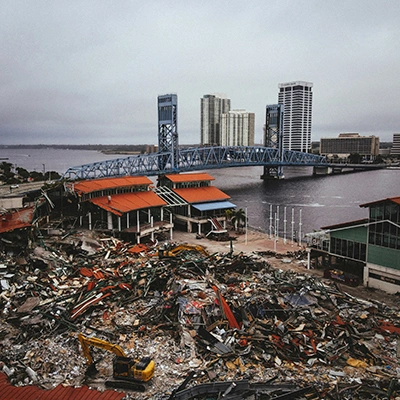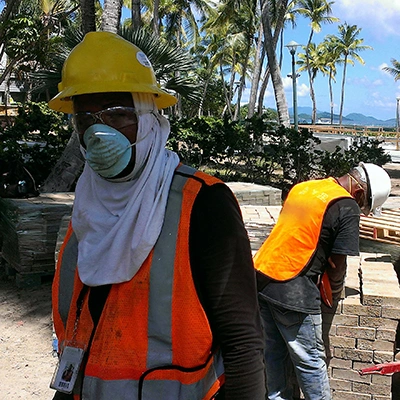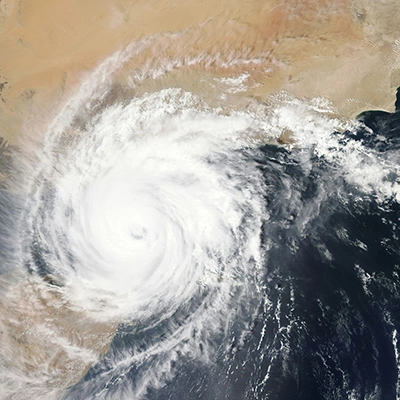The outrage was real. In between watching images on the news of wildfires in Hawaii and Greece, we scrolled through Instagram to see people having fun on the beach in those same locations. “How can they do that in the face of disaster?!?” people questioned.
Even in the aftermath, we asked about returning to Maui and Rhodes. Should you travel after a natural disaster? How soon should you travel somewhere after a disaster? Can tourism help recovery?
They’re good questions and important ones to ask when you’re trying to be a responsible tourist. While there are no definitive answers, we can help you unpack if and when you can get back to the destinations you love.
What Is Disaster Tourism?
Disaster tourism is a type of dark tourism where you travel to the site of a disaster — natural or manmade — with the specific purpose of witnessing the atrocity.
Now, there is a difference, however slight, between disaster tourism and going to a country or region that has recently suffered a disaster. With true disaster tourism, it’s about satisfying your personal curiosity. Some consider this somewhat grotesque and inappropriate. This is what leads to some of the debate we’ll unpack in the sections below.
In the other scenario, you might be traveling to the site of a disaster, but the intention is different. You want to support the destination in some manner, not gawk at its misfortune. This is an important distinction when deciding whether it’s safe — and responsible — to travel after a natural disaster.
Should I Travel After a Natural Disaster?
There are two camps and a lot of gray area in this debate. Both sides have valid points, and they’re all true depending on the situation.
Why don’t countries like tourists in the aftermath of a natural disaster?

You don’t want to get in the way of relief efforts, either. There’s a lot of rescue and cleanup that needs to happen so that locals can mourn, recover, and try to get back to normal life. If your presence inhibits that, stay away.
It’s tempting to say, “But I can make a difference!” Sometimes the best way to lend a hand to relief efforts, though, is by donating money or resources like food and medicine. Choose a reputable organization, and let them deliver your donation while you stay home, at least for now.
Similarly, our presence, even when well-intentioned, can put a strain on local resources. During and immediately after a natural disaster, locations need all the food, drinkable water, and services they can get. Don’t be the person who booked a hotel room for disaster tourism when someone whose home was destroyed could use it to live in.
Lastly, it’s about being a compassionate traveler. Visiting a place affected by a disaster can squash misconceptions of a place, helping us to see firsthand what really happens. That can be a powerful experience.
However, you also have to remember that these are places where people have lost their homes and their lives. They are not places for selfies or rubbernecking. Locals often come to resent what they perceive to be voyeurs taking advantage of their anguish.
Why should you travel after a natural disaster?
Of all the good reasons to travel after a natural disaster, the most common is because your tourism dollars can make a difference. Particularly if your destination relies heavily on travel for income, your continued business can go a long way.

Simply put, without tourism, businesses close, employees lose their jobs, and locals struggle to rebuild their lives.
It’s also important to realize that not all areas are impacted by natural disasters in the same way. Responsible Travel highlighted the difference in recovery for Morocco versus Nepal. Both countries suffered powerful earthquakes, one in 2023, the other in 2015. For a variety of reasons, travel to Morocco continued almost unimpeded within days. It was years, however, before Nepal’s tourism industry fully recovered.
Even in the case of Morocco, it’s impossible to paint the entire country with a single brushstroke. Urban areas, even in the midst of severe destruction, had better access to resources so that they could reopen businesses and welcome travelers. Rural areas were a different story. It took much longer to rebuild, impacting their ability to host trekkers and other tourists.
In an instance such as this, to say that you shouldn’t have traveled to Morocco at all in the aftermath of the earthquake would have done a disservice to the regions that were ready and able to welcome tourists. Not every city will be equipped for your arrival, but for those that are, your contribution to the local economy can directly impact those who need it.
When Should I Travel After a Disaster?
Once you’ve decided that it’s okay visiting a destination after it’s suffered a natural disaster, it becomes a question of timing. When should you travel?
One of the best guidelines is to wait until after relief workers have left. Like we said, you don’t want to interfere with emergency efforts, and you don’t want to take valuable resources away from locals. But once the initial wave of professional relief workers has departed, that’s a good sign that the immediate danger has passed.
This next one is tough to identify, but you might wait until what’s happened has gone from current events to history. If the event is still news, there’s a chance people are still mourning and emotions are raw. Whether it’s an earthquake, tornado, hurricane, mudslide, or any other natural disaster, people may have lost loved ones. When a destination is still reeling, it may be appropriate for you to keep your distance. Give them time to heal without intrusion.
When in doubt, check with local, reputable travel agencies. This could be an independent travel agent, a hotel you booked with, the company leading a tour, or even an airline. They should have a good understanding of the severity of the disaster and how widespread it is. This firsthand information will serve as a good guide for your decision.
How to Travel Responsibly After a Natural Disaster
1. Research, research, research.
Know the area or areas that were affected. News coverage of Australia’s 2020 wildfires made many of us think the entire country was in danger. In reality, while truly awful, it only affected a region the size of Wisconsin. It would have been possible — and responsible — to travel to other cities without impeding rescue efforts or depleting resources in the affected area.
On a related note, try to uncover the difference between media coverage and reality. If possible, talk to locals and get the real story about what’s going on.
Lastly, see if your destination provides up-to-date information about what is and isn’t open. Puerto Rico, with its history of hurricanes, has a website with real-time experience updates. You can check at any time whether major points of interest, beaches, and other attractions are open, have limited services, or are closed temporarily.
2. Be flexible with your itinerary.
In our Australia example, visiting Canberra would have been a bad idea, if not impossible. However, by visiting Perth on the other side of the country, you would likely have been fine. In other words, go where the damage isn’t.
If your heart is set on a specific destination, try to be flexible with your timing. Even if the immediate danger has passed and tourism as restarted, your tourism dollars could be extra appreciated if you travel during the off-season. This is usually a time when businesses feel the economic pinch anyway, and that struggle can feel even greater when they’re still trying to recover from a disaster.
3. Book with a reputable travel company.
A good travel company will help you adjust your itinerary as needed, whether it means steering clear of dangerous locations, identifying local businesses you could support, or providing dependable advice on how to explore the site responsibly.
When helping the destination’s recovery is high on your priority list, look for a company that can help beyond just planning your trip. They might donate a portion of the proceeds from your trip to special causes. They might be able to choose activities that aid specifically in sustainability – rewilding, rebuilding beaches and marine areas, reconstructing buildings that are better for the environment and better able to withstand the next natural disaster.
A reputable travel company has your welfare in mind as well as that of the community you’re visiting.
4. Be mindful and sensitive.
In a nutshell, think before you act.
Don’t take photos of the disaster. That pile of rubble was once someone’s home. Don’t hound locals about their experiences. It’s not a story, it’s their own personal nightmare. And don’t crash a memorial service. It’s just plain rude.
5. Adjust your expectations.
Service might be slower than usual. Items might be in short supply or unavailable. Some experts say to “lower your expectations,” but we prefer the more optimistic perspective of simply adjusting them. It might not be the vacation you imagined, full of perfection and luxury, but it could reveal something even more extraordinary if you keep your eyes and mind open.
6. Shop local.
This is a great tip for any kind of responsible, sustainable travel, and it couldn’t be more true here. When you choose to travel to boost the tourism industry after a disaster, choose local businesses so that your dollars go directly to the community.
Look for restaurants, hotels, guides, transportation, and more owned right there in the heart of the destination.
7. Volunteer with intention.
Voluntourism can be a force for good. If you have the skills and motivation, look for reputable mission groups or nonprofits that work in the area and can connect you with a project. As opposed to some voluntour trips that run on a repeat basis — a new wave of tourists comes to work at a clinic every few weeks — your voluntour experience should serve a specific need related to the disaster.
Don’t just show up unannounced expecting to “help out.” Plan responsibly so that you go where you’re needed most and can make the biggest impact.
Travel Insurance for Natural Disasters
Some natural disasters give you warning. Some don’t. Either way, it’s important to be prepared when you travel.

When disaster strikes during your trip, travel insurance can help in many ways such as trip interruption and trip delay benefits.
And remember what we said about not taking resources away from locals? Travel insurance can help there, too, making it easier for you to get where you need to be or cover medical expenses so that you don’t become an undue burden on your hosts.
If you’re traveling in the aftermath of a disaster, travel insurance can also give you the flexibility to adjust your plans as needed. Optional benefits like Cancel for Any Reason (CFAR) and Interruption for Any Reason (IFAR) could be especially helpful in case you have a change of heart about traveling and either want to stay home (CFAR) or come home early (IFAR).
Visit SevenCorners.com to find the right travel insurance for your trip. Alternatively, contact our licensed agents to help you navigate the ins and outs of travel insurance for your unique trip.
Travel Like a Pro with The Wayfinder
Did you enjoy this blog? Get more articles like it before anyone else when you subscribe to our monthly newsletter, The Wayfinder.
Sign me up
